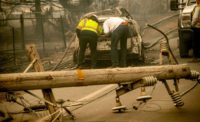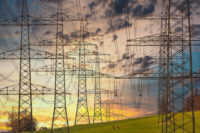PG&E Faces Billions in Grid Work Amid Bankruptcy Crisis

PG&E filed bankruptcy after the 2018 Camp Fire.
PHOTO: MIKE ELIASON/SANTA BARBARA COUNTY FIRE DEPARTMENT VIA A.P. FILE
Major electric grid work is ahead in PG&E’s territory, whether or not the California electric and gas utility files for bankruptcy. Faced with billions in potential liability from November’s Camp Fire, PG&E announced Jan. 14 it intends to file for Chapter 11 bankruptcy proceedings on Jan. 29.
The California Dept. of Forestry and Fire Protection (Cal Fire) is still investigating the Camp Fire, in which 86 people died. But the utility reported damage to a 115,000-volt transmission line in the area shortly before the blaze started, and it is already facing lawsuits stemming from it. Under state law, utilities are responsible for fires caused by their equipment. Additionally, Cal Fire has determined that PG&E caused 18 wildfires in 2017.
Though it faces a massive reorganization, the utility says it will maintain electric and gas service and it understands the “need for PG&E to continue enhancing our wildfire mitigation efforts.” The company has spent more than $1 billion making the grid more resistant to fire and wind by insulating wires, replacing wood poles with metal poles and widening the gap between wires. In December, it filed a rate case with the California Public Utilities Commission to spend $5 billion from 2018 to 2022 to expand and accelerate that work. That case is pending.
A Jan. 30 hearing may supercharge the work. A federal judge overseeing the utility’s probation related to the 2010 San Bruno gas line explosion has proposed to order the utility to reinspect all of its electric grid by June 21, the start of the wildfire season. The order, which could be implemented after the hearing, would require the utility to trim trees; identify and fix all conductors that might swing together or arc; identify and fix damaged or weakened poles, transformers and fuses and other connectors; and rectify “any other condition anywhere in its grid similar to any condition that contributed to any previous wildfires.”
In areas uninspected so far, with equipment that could cause wildfires, the judge, William Alsup of the Northern District of California, says PG&E must de-energize power lines during high winds. In a Jan. 17 court filing, Alsup said that after studying materials provided by PG&E, the court had determined that the single most recurring cause of the 2017 and 2018 fires was trees and limbs falling on lines during high winds, coupled with uninsulated power conductors that were pushed together, causing sparks to fall.




